#iwasaki art museum
Text

Poster
food creation 「sensuous food, emotional taste, フードクリエイション 食欲のデザイン展 感覚であじわう 感情のテイスト」
art direction & design:
Naoko Fukuoka 福岡南央子_woolen
artist: food creation
photo: Hiroshi Iwasaki 岩崎寛
CL: 21st Century Museum of Contemporary Art, Kanazawa 金沢21世紀美術館
2008
#graphic#packagedesign#graphicdesign#design_by_woolen#naokofukuoka#woolen#福岡南央子#foodcreation#諏訪綾子#ayakosuwa#exhibition#exhibitiongraphic#poster
2 notes
·
View notes
Text
Yeong's Thoughts on Taitō Division

Azusa Furukawa
"Ah, the dojo master's daughter! From what I've heard, her family owns one of the few remaining dojos in Japan right now. After Chuohku took power, they developed the HypMics, which pretty much made weaponry, martial arts, and dojos nothing more than relics of the past. Now they're pretty much just used as art to hang on walls to remind us of days gone by.
"It's sad once you think about it. My master's dojo was like a second home to me. The place wasn't very wide or big, but it was there I didn't have to worry about the expectations society or my parents put on me." Yeong sighs. "It makes me sad to think about those times..."
Fleuret Oshiro
"...You know, seeing this woman just reminded me of something important. I've lived in Japan for about three years now. And can you believe in all that time, I've never once set foot inside the Tokyo National Museum?! What is wrong with me?! Vito has gone numerous times! Even Saji has stepped foot inside there once or twice! Man, I've got to find time to head over to Taitō and check that place out! Yeong sighs. "Okay, now that my little rant's over...
"From what Vito tells me, this woman seems to be quite intellectual. No real surprise considering she works as a curator there. Seriously, I've got to make time to visit. I bet they have some cool Korean art in there!"
Eldrid Iwasaki
"Woah, "The Valkyrie", herself! Man, I've seen Saji and Vito kick ass before, and I'm not gonna lie, the both of them can kick some major ass! But, no offense to either of them, they don't hold a candle to this woman! Seriously, it's no surprise that she's the longest-reigning MMA Champion the sport has seen! I'm tempted to try my hand with her, but I'm afraid too. I'm a model, less you forget! I need my face and good looks!"
Blade Maiden
"Man, all three of these women are dangerous! No surprise considering they descend from Samurai, Knights, and Vikings! It makes me wonder what kind of line I descend from. ...No, let's not go there. The less I have to think about my family or parents or whatever, the better. But seriously, I'm a bit hesitant to face these guys. They've been in the D.R.B. for a while, and even though they've only one fight, they're still pretty dominant. I hope we can, at least, give them a good fight!"
#hypmic#hypmic oc#hypnosis mic#hypnosis mic oc#hypnosis microphone#meguro division#yeong hajoon#taito division#blade maiden#azusa furukawa#fleuret oshiro#eldrid iwasaki
7 notes
·
View notes
Text
Ryūzō's Thoughts on Taitō Division

Azusa Furukawa
"Takumi has told me much about the Furukawas. They seem to be a prestigious family descending from the time of the Samurai. I'm surprised my family has no history of interactions with them. But then again, we were always a reclusive people, who didn't really see the point in making friendships." He looks away, mumbling something under his breath. "They may have been the reason we were wiped out so easily..."
He looks back at the screen. "In any case, I hear she is joining the tournament to preserve her family's dojo, which is a noble goal, I'll admit. Despite the fact that swords are no longer as popular as they once were, keeping one's sword arm sharp is a wise thing to do."
Fleuret Oshiro
"I'm not acquainted with Oshiro-san, but I have visited the Tokyo Museum on occasion. It is truly a wonderous place with a lot of history inside of it. ...Perhaps I should commission the head of the Academy to think about taking the entire student body on a trip there as a class project."
Eldrid Iwasaki
"I've heard a lot about Iwasaki-san, mainly her fighting career. Granted, I don't keep up with MMA, nor am I a fan of it. But I have seen a few of her matches when I was watching it with Takumi-san. I have to admit, I find the mass array of martial arts that are present within the organization to be quite fascinating."
Blade Maiden
"It's not surprising that this group has come together. All of them hail from proud and prestigious bloodlines. I have to wonder what my ancestors would think if they could see my family now... But in any case, all three women are worthy of respect. I'll definitely be watching their process in the D.R.B."
#hypnosis mic oc#hypmic#hypmic oc#hypnosis mic#hypnosis microphone#kiya kara#sendai division#ryūzō mizutori#taito division#azusa furukawa#fleuret oshiro#eldrid iwasaki#blade maiden
8 notes
·
View notes
Text
Chihiro Iwasaki is one of the representative Japanese picture book writers.
The combination of transparent, colorful watercolor and simple lines is distinctive. In particular, her drawing children and their moods are outstanding.
The picture of the child hiding into the curtains reminded me of the same thing I had done, and it was fun for me.
Chihiro Art Museum are located in Tokyo and Nagano. Nagano one is surrounded by beautiful nature. It's a highly recommended place for people who interested in.
Please browse official site:
https://chihiro.jp/en/


1 note
·
View note
Text
Artist / Credit

Etsuko Ichihara
Artist, Fantasy inventor, Digital Shamanist
Etsuko Ichihara is Japanese artist. Born 1988 in Aichi. Graduated in Studies of Media, Body and Image from the School of Culture, Media and Society, Waseda University. She has been creating artworks that interpret Japanese culture, customs and beliefs from a unique point of view, and present new, technology-based approaches. Thanks to their strong impact, these works have been introduced across a wide range of media all over the world, such as newspapers and TV programs, radio programs, and magazines.
Ichihara’s works were included in the Excellence Award at the 20th Japan Media Arts Festival, Entertainment Division in 2017, and in 2016, chosen for the INNOvation program from The Ministry of Internal Affairs and Communications. She won Honorary Mention (Interactive Art+) in PRIX Ars Electronica 2018 and received a STARTS Prize Nomination in the same year recently.
She has recently presented her works in exhibitions such as ‘Digital Shamanism: Japanese Funeral and Festivity’ at NTT InterCommunication Center [ICC], ‘Cyber Arts Exhibition 2018’ at Ars Electronica Festival in Linz, Japan Media Arts Festival, ‘Mediating Asia’ at National Taiwan Museum of Fine Arts, ‘Roppongi Crossing 2022’ at the Mori Art Museum.

Interview at toco toco TV
youtube
TEDxUTokyo(Japanese)
youtube
Credits
Conveyor mechanical design and development: Hayashi Tamio (TASKO Inc.)
Technical direction: Okiyama Ryota (TASKO Inc.), Kimura Masataka (TASKO Inc.)
Sushi plate device development and installation: Nakaji Hiroaki
Food sample modeling cooperation: Sato Sample, IWASAKI CO., LTD.
Robot application development: Watanabe Chika
Scenography cooperation: Sammonji Masaya (BKY+SENTO-DASHI committee), Uchiumi Kohei (BKY+SENTO-DASHI committee)
Logo design: Hata Yurie
Translation: Sato Ayako
Cast: Fujii Naotaka, Mishima Yuta, Hokamura Hitoshi
Video Supervision: Sakamoto Asato
Support received from
Production cooperation: Digital Hollywood University, 100BANCH, Poled Co., Ltd, ZENTech, Inc., Nofty, Inc., Kazuo Wakamiya
Technical cooperation: TASKO Inc., RYUDOSHOTEN L.L.C., yakushoku saffrondo, BnA Co.,Ltd
Cooperation: Mori Art Museum
0 notes
Text
bibliography
Hirasuna, Delphine. The Art of Gaman: Arts and Crafts from the Japanese American Internment Camps 1942-1946. Google Books, Clarkson Potter/Ten Speed, 19 Nov. 2013, books.google.com/books?hl=en&lr=&id=_cseAAAAQBAJ&oi=fnd&pg=PT9&dq=japanese+internment+camps+life+inside&ots=7UmMg9H6zf&sig=vw_QuRYjttXPaH9AGVCTyT-ZZLM#v=onepage&q=japanese%20internment%20camps%20life%20inside&f=false. Accessed 10 Feb. 2023. This book very specifically details the process of the Japanese internment camps as well as what it was like inside of the internment camps (art, day to day, etc.) I believe this will be a helpful source for my map.
Pettersen, William. Success Story, Japanese-American Style. 9 Jan. 1966. This piece almost seems to justify what was done to Japanese-Americans because it “made them better” and tries to argue that how we treat minorities is not to blame because their levels of success are completely based on “how hard they work”, undercutting the plight and discrimination of black people in the United States.
Densho Digital Repository. “Ddr-Manz-1-112-15 — Toshiko Aiboshi Interview Segment 15 | Densho Digital Repository.” Ddr.densho.org, ddr.densho.org/interviews/ddr-manz-1-112-15/?tableft=segments. Accessed 20 Jan. 2011. This series of interviews with Tokisho Aiboshi documents her specific experience through the process of the internment camps and provides insight into how young Nisei children experienced the confusing and rash decisions of government officials.
https://ddr.densho.org/interviews/ddr-manz-1-1-1/
Dennis- orphan in the children’s village
Saavedra, Martin. Early Childhood Conditions and Mortality: Evidence from Japanese American Internment ∗. University of Pittsburgh, 20 Aug. 2013. What’s interesting about this source is that it documents long-term health impacts caused by internment camps. I believe this will contribute to my map because I hope to map the effects that internment camps had beyond the war.
López-Calvo, Ignacio. One World Periphery Reads the Other. Cambridge Scholars Publishing, 14 Dec. 2009, p. 130. I had not realized before reading this that Japanese people living in Latin American countries were affected by the concentration camps. People of Japanese descent living in countries like Peru were located and deported to the United States so they could be sent to concentration camps and after the fact were denied re-entry. Not only had the US nearly forgotten about them after the war, the countries they had come from used this as a way of keeping them out of their countries, while they were lenient with German immigrants.
https://time.com/5743555/wwii-incarceration-japanese-latin-americans/
Yoshida, Helen. “Redress and Reparations for Japanese American Incarceration.” The National WWII Museum | New Orleans, 13 Aug. 2021, www.nationalww2museum.org/war/articles/redress-and-reparations-japanese-american-incarceration. This article follows the story of Amy Iwasaki Mass and others, who was just a young girl when incarcerated. Mass went on to become a social worker who helped with the Civil Liberties Act of 1988. This article describes the lengthy process of receiving reparations for Japanese Americans. For my map, I would like to highlight the amount of time and processes that it took to even get to this point, and hopefully point out the areas it failed to address as well.
Fickle, Tara. “NO-NO BOY’S DILEMMA: GAME THEORY AND JAPANESE AMERICAN INTERNMENT LITERATURE.” Modern Fiction Studies, vol. 60, no. 4, 2014, pp. 740–66. JSTOR, https://www.jstor.org/stable/26421755. Accessed 10 Feb. 2023. In No No Boy’s Dilema, Tara Fickle attempts to use game theory to explain how Asian-Americans and more specifically Japanese-Americans have been used as pawns and also the way in which the government viewed its own citizens as players.
Tokunaga, Yu. “Japanese Internment as an Agricultural Labor Crisis: Wartime Debates over Food Security versus Military Necessity.” Southern California Quarterly, vol. 101, no. 1, 2019, pp. 79–113. JSTOR, https://www.jstor.org/stable/27085976. Accessed 10 Feb. 2023. This article discusses the very real change in agricultural production because of Japanese internment. One thing I really like about this source is that it reminds me of our Nation’s continued prioritization of militarization over the general public’s well being. This applies to the overuse of police force currently as opposed to social reform and it also applies in this article to the food shortage caused by the rash and racist military decision to impose internment camps.
0 notes
Text
i've updated the muse pages! all new muse additions are below the cut!
canons -

takuto m.aruki (Per.sona 5 / P5R)

Akihiko Sanada
*YES i'm re-adding Akihiko. I'm weak and i love him & P3P getting rereleased got me feelin things

shinjiro ar.agaki (Pers.ona 3)

rio iwasaki (Pers.ona 3)

Prince.ss Daisy (nin.tendo)

Nicol Ascart (My Next Life As a Vill.ainess)

Anne Shelly (My Next Life As a Vill.ainess)

Geordo Stuart (My Next Life As a Vill.ainess)

Alan Suart (My Next Life As a Vill.ainess)

Sora Smith (My Next Life As a Vill.ainess)

Goldie / Goldielocks (Puss In Boots: The Las.t Wish)
ocs -

Teagan Jenson
fandomless oc & multiversed / museum tour guide & art lover. inspired by various sources.
*oc popup currently wip / unavailable.
#// as u can see- my next life as a villainess still has me on a chokehold#// but also-- i love all of these characters a lot#// dew is also picking up goldie so we're gonna twin it up lol#// Perso.na still has me in a chokehold too but that's beside the point lmao#tbd later //
0 notes
Photo


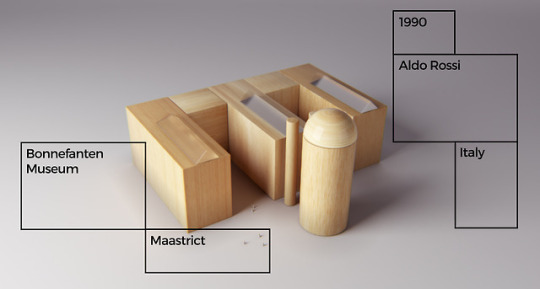



vimeo
MY FIRST PRITZKER
A list of the 41 winners of this incredible prize.
1988 • Oscar Niemeyer • Niterói Contemporary Art Museum
1989 • Frank Gehry • Guggenheim Museum
1990 • Aldo Rossi • Bonnefanten Museum
1991 • Robert Venturi • Vanna Venturi House
1992 • Alvaro Siza • Servei de Meteorologica
1993 • Fumihiko Maki • Iwasaki Art Museum
#Architecture#Design#motion graphics#pritzker prize#Oscar Niemeyer#Niterói Contemporary Art Museum#Frank Gehry#Guggenheim Museum#Aldo Rossi#Bonnefanten Museum#Robert Venturi#Vanna Venturi House#Alvaro Siza#Fumihiko Maki#Iwasaki Art Museum#Servei de Meteorologica#Animation
686 notes
·
View notes
Text
Reviews 227: Kankyō Ongaku
In 2017, Light in the Attic initiated an ambitious project, one seeking to survey and contextualize the modern musical history of Japan. The first release in their so-called Japan Archival Series was Even a Tree Can Shed Tears: Japanese Folk & Rock 1969 -1975, an extensive celebration of Japan’s “New Music” scene. One of the artists that emerged from this era was Haruomi Hosono, whose discography the label visited during 2018 as part of their Haruomi Hosono Archival Series (which I covered extensively here), taking a slight detour from the more general overview of modern Japanese music to celebrate one of the world’s most enigmatic and creative sonic minds. And now, at the start of 2019, Light in the Attic’s Japan Archival Series resumes with the stunning Kankyō Ongaku: Japanese Ambient, Environmental, & New Age Music 1980 - 1990.
An introductory essay by project mastermind Spencer Doran (and a complimentary Vinyl Factory interview) paint an incredible picture of unique moment in history, when the lines between pop art, science, corporate capitalism, and new age healing all seemed to blur together. Heady modern philosophies inspired by Eno, Satie, and ancient musical traditions such as Hosono’s “oceanic feeling” and “sightseeing music,” Satoshi Ashikawa’s notions of passive environmental ambiance, and Hiroshi Yoshimura’s modes of silent tranquility all came to life within a period of great economic prosperity and technological advancement, which afforded the myriad artists and sound designers new methods and experimental avenues to display their vibratory art. This was a time when corporations, exhibition curators, theater producers, fashion designers, and advertisers all sought out musical explorers, both popular and obscure, to create wonderfully experimental compositions in conversation with the environments that surrounded them….a time when you could walk through a museum or department store and hear deeply mystical or adventurously cosmic music spilling out into the air. As well, the essay traces how Japanese environmental music, or kankyō ongaku, adapted and expanded over time, specifically its folding in of new age textures and natural field recordings as people sought an escape from the frantic energies of modern life.
Visually, the collection is adorned with gorgeous photography of the Fumihiko Maki-designed Iwasaki Art Museum, a location and architect that both play a large role in this musical story. And beyond the introductory essay, there are well-researched descriptions and bios by Spencer and Yosuke Kitazawa that provide context and history for each and every track, with contemporaneous photos, fliers, and album covers accompanying the words. Musically, the set comprises a completely immersive and beautifully sequenced experience, one that features glowing electric piano dreamscapes, minimalist organ psychedelics, aquatic synth experimentations, spiritual stone meditations, tropical fusion glides, kosmische sound baths, underwater ambient adventures, and so much else besides. In this way, the compilation is also positioned within a larger context…a sort of global movement of space music, new age, and ambient that Light in the Attic has been exploring via their I Am the Center and (The Microcosm) collections, with Kankyō Ongaku seeking to do for Japan what those releases did for America and Europe, respectively.
Kankyō Ongaku: Japanese Ambient, Environmental, & New Age Music 1980 - 1990 (Light in the Attic, 2019)
Though his life was tragically short, Satoshi Ashikawa looms large in the world of kankyō ongaku, not only for his compositions and philosophies, but also due to working at the influential Art Vivant book and record shop, a sort of cultural hub and early importer of avant garde, ambient, and minimalist music within Japan. His “Still Space” sees crystallized FM pianos moving through starlight note clusters and atonal chord bursts, with a backing of vaporous string swells. The sounds evoke leaves blowing in the wind and slow motion ripples on the surface of a pond and Satoshi is just as interested in silence, with chasms of empty space sitting between the patient, methodical, and meditative melodies. Yoshio Ojima’s “Glass Chattering” is taken from Une Collection Des Chainons: Music for Spiral, his 2xCD masterwork created for Wacoal’s Spiral building…another important architectural space within the environmental music scene designed by Fumihiko Maki. Underwater computer sequences sound like seafloor vents letting out streams of liquid glass while space flutes swim overhead. The dazzling electronics briefly recede, leaving synthetic woodwinds to intertwine and flow freely. And once the vibrant sequential patterns return, melancholic orchestrations are discernible within their movements, only obscured by watery percolations. Pale synth streaks drift on echowaves then fade away during a false ending, with the silence soon replaced by a looping vortex of polychromatic music boxes and shimmering chimes with gentle pads walking underneath…their spacious notes decaying through reverb caverns.
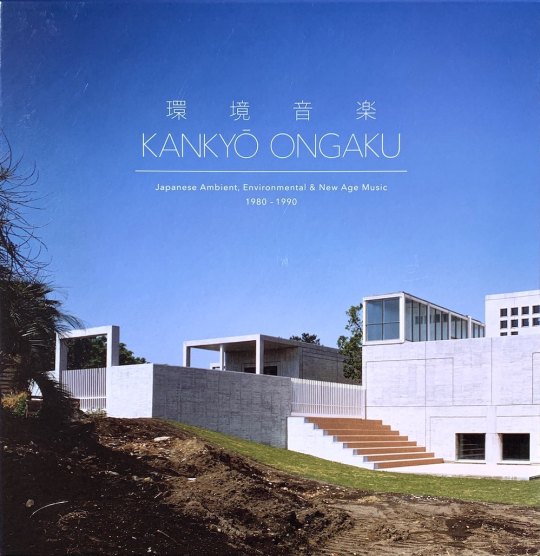
One of my favorite aspects of this compilation is how it goes out of its way to pay tribute to Hideki Matsutake, the un-official fourth member and sound programmer of Yellow Magic Orchestra and expert synthesizer technician who rarely gets his due. “Nemureru Yoru” was originally conceived as a novelty sleep aid and is presented here in its instrumental form. Wavering pads and whistling sequences generate playful vibes of childlike wonder before fading into a phaser-blasted drone expanse, wherein pillowy 808 kicks sit below synthetic approximations of traintrack clicks and dripping liquids. And as heatwave static mirages create psychedelic patterns that wrap around the body, dreamtime arps constructed from filtering feedback flutters lull the mind into relaxation. Then comes a track by Ayuo Takahashi, who spent his teens jamming with Ryuichi Sakamato and those lords of molten psychedelia Fushitsusha before embarking on an adventurous solo career marrying modern electronics and ancient and medieval musical traditions. “Nagareru” is intensely beautiful and starts with gentle piano arpeggios intertwining with waterfall solo cascades as shimmering bell strands and twinkling chime vibrations suffuse the background. String synths and kosmische organs swell with majestic orchestrations while Ayuo’s piano journeys into the clouds…all setting the stage for the introduction of Koharu Kisaragi, a radiant goddess whose cosmic angel voice soars through gaseous fx layers and star ocean expanses.

Of all the artists appearing here, Joe Hisashi has one of the most storied careers. He’s a musical polyglot, equally comfortable exploring anime and video game OSTs, classical music, and vocal pop. But for Kankyō Ongaku, we focus on Joe’s more obscure and psychedelic side with Wonder City Orchestra’s “Islander.” Owing to his early interests in American minimalism, “Islander” is deeply indebted to Terry Riley, with bubbly organ patterns moved over by ring modulated steel drum sequences and aquamarine pad swells. Rainforest drum panoramas work into the mix with rolling finger motions and sunshine rhythm energies while kosmische organ smears swirl like a galactic gas cloud. And best of all, psychoactive organ pulsations fly through time-lag accumulators, creating rapid motion dreamspells and hypnotizing crystal cascades. Yoshiaki’s Ochi “Ear Dreamin’” is another piece closely associated with Wacoal and the Spiral Building, though it was originally written as part of a stage performance entitled Natural Sonic from 1983. Layered mbiras, balafons, bell-tone shimmers, and lullaby chimes work together as whistling melodies fly through the sky…everything coming together for a polyrhythmic dance of idiophonic magic. Mermaid choirs float up from deep sea depths as wooden planks vibrate, metal tines oscillate, and bulbous gourds rattle and dazzling solo flights occasionally break-free from the Afro-minimalist dream weavings.

The liner notes cast Masashi Kitamura as somewhat of an outsider, one more involved with Japan’s prog, punk, and noise scenes than anything overlapping with kankyō ongaku. However, “Variation·III” from 1984, which was released with his band Phonogenix, fits nicely within this compilation’s larger sonic aesthetic, as triangle chimes ring out over waves of water and static. Bleary ambient tones drift in…as if funereal choirs and swells of synth and guitar ambiance have been submerged within a viscous gray fluid. Thunderous drum smacks sit loudly in the mix while mutating vibrato waves and currents of burning noise wash over the mind and at some point, bowed string instruments scream into the void. One of several Haruomi Hosono-produced tracks here is “Park” by Interior. Clicks and snaps background impressionistic smears of synth brass while drunken sequences dance through fragile melodies. Time flows in nonsensical ways and everything cycles according to a hazy dream logic as the track builds towards a climax of whip-crack drum fx and heavenly organs playing spring meadow hymns. The next track was produced by Sankai Juku dance troupe director and SCI Prophet-5 wizard Yoichiro Yoshikawa for a documentary series called The Miracle Planet (NHK, 1987). In “Nube,” galactic revolutions of aquatic synthesis surround massive bass waves and obscured male choirs that mutate through tremolo breaths. Thrilling filter ascents are immersed within sea-blue vortices and currents of black fog while elsewhere, feedback wisps and spiritual drone baths circle together.
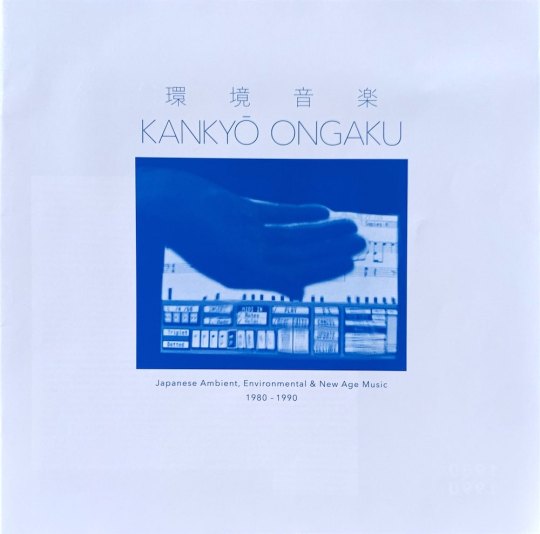
Yoshio Suzuki has a rather impressive jazz background, having worked with titans such as Art Blakey and Sonny Rollins during the 70s before exploring softer sounds in the 80s via the use of synthesizers. Taken from Morning Picture, which was produced as part of series of ambient home listening releases by JVC, “Meet Me in the Sleep Meadow” finds hallucinatory synth pianos swimming through a thick haze, with all sorts of magical modulations added via tape warble and wow’n’flutter. And as Yoshio’s gentle Oberheim fantasias move above wispy swells, I’m reminded of the spaciousness and meditative wonder found in Satoshi Ashikawa’s work. Ryuichi Sakamoto needs no introduction and his “Dolphins” (from a dance piece by Molissa Fenley called Esperanto) is utterly beguiling, with aqueous swells of heaven bringing in reverb-smothered piano chords that seem to decay from infinite clifftops. Backwards flowing noise hazes and sea-form delay sprays sit above cut-up voices, skittering cyborg loops, staccato conversations, and droning machine breaths, all while Yas-Kaz’s improvised marimbas dance on sunbeams. One of the most interesting pieces here comes from Toshi Tsuchitori, originally a jazz drummer who drifted towards archeological musicology and ancient instrumentation. His “Ishiura” is played on sanukaito stones and sees earthen energies flowing forth from vibrating volcanic rocks. A tambourine rattles softly as Toshi creates vocal tremolo waves and overlapping resonances from stone, with his soft taps and violent bursts sometimes evoking wind chimes, other times a gamelan ensemble.
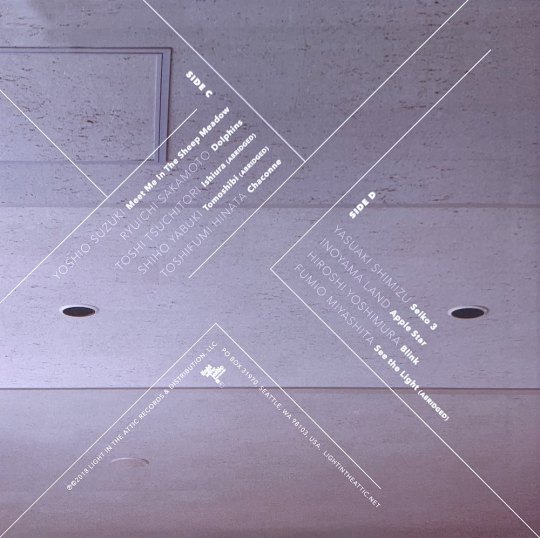
Shiho Yabuki is yet another figure who started in the world of jazz and then opened up her sound via synthesizers and research into traditional musics. In “Tomoshibi,” which is part of an album dedicated to the 1200th anniversary of the Enryaku-ji monastery, gemstone feedback fluids waver through the void…as if hallucinatory streaks of sonic mesmerism are flowing forth from a string instrument made of pure crystal. Soft plucks generate massive rainbow wavefronts while celestial zithers cascade on echo-currents and as it progresses, the track evolves into a hypnotic dance of purifying feedback melodics and Laraaji-style deep sea new age. Toshifumi Hinata produced “Chaconne” with his brother Daisuke, who was a member of Interiror. The song comes from Toshifumi’s first album Sarah’s Crime and presages his breakthrough as a TV and film composer. We begin with sirens calling out from an island of dreams…their voices flowing through pearlescent clouds of self-oscillating delay magic and constantly threatening to spill over into resonant feedback chaos. Cosmic harpsichord sequences dance through asteroid fields and melodious bass pads flow out from the center of the cosmos with lush symphonic movements and shadowy dream transitions. Klaus Schulze-style key changes swim within a kosmische sound bath…the sequences and melodic fogs sweeping upwards through minor and major key ecstasies as pianos splash through tide pools of ether.
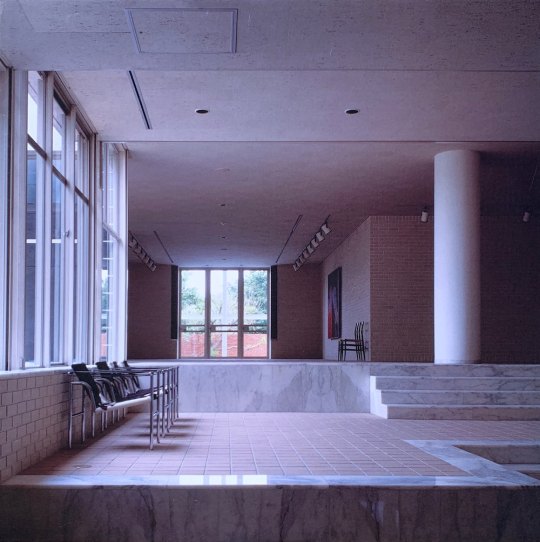
The adventurously far-out career of Yasuaki Shimizu intersected often with the world of kankyō ongaku, many examples of which were collected on 1987’s Music for Commercials. “Seiko 3” comes from this release and sees Yasuaki scoring a Seiko watch commercial alongside sound designer Seigen Ono. But this seemingly shallow corporate concept betrays the deep mysticism of the music, as starlight sequences and ever-flowing chime strands descend across universal expanses. Pulsing brass pads blare out and gentle submarine pings float through the ether while breathtaking polysynth movements swell in strength…the soul floating towards a cloud paradise of unimaginable color before it all cuts away. The krautrock and kosmische inspired synth fantasias and pastoral prog dreamscapes of Inoyama Land caught the attention of Haruomi Hosono in the early 80s, whole then produced and released their stunning Danzindan-Pojidon LP. “Apple Star” comes from that album and explores sunshine minimalism as played on alien sequencers. Filtering and morphing synths dance in each ear with hypnotizing patterns of futurist psychedelia while Solina string orchestrions fly through ecstasy phasers. Hosono’s water tank delay system gives the whole track a sort of mystic sic-fi aura, as ancient earth materials are used for space age purposes. Sparkling chime strands work into the mix…these thrilling descents up and down the scale that weave fairytale polyrhythms and seascape panoramas, all while the ever pulsating keyboard patterns induce paradise trance states and interstellar string melodies swell the heart.
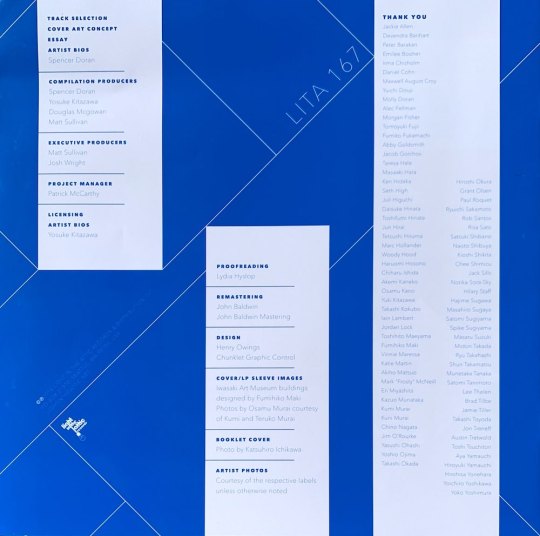
Like Satoshi Ashikawa, the influence of Hiroshi Yoshimura on kankyō ongaku is hard to overstate…an intrepid pioneer and cultural historian who wrote extensively about sound art and whose music found its way into “prefab model homes, train stations, public pavilions, cosmetic companies, and fashion shows,” in addition to traditional avenues of release. “Blink,” taken from Music for Nine Post Cards, is built around dreamy electric piano conversations that flow across the stereo field. Inspired by the view from Hiroshi’ss window, the music evokes cloud shadows moving over serene landscapes, hypnotic snowfall motions, grey waves crashing to shore, boats rocking gently in a paradise lagoon, the growth of grass, and the fluttering of butterfly wings. And ever so often, the hazy piano dream weavings are back by softly swelling strings and ambient orchestral gases. Cosmic prog and stoner psych legends Far East Family Band proved to be fertile breeding ground for new age music, with Kitaro, Fumio Miyashita, and Akira Ito all going on to have long careers of exploratory sonic healing. Fumio Miyashita’s “See the Light” appears here and begins within a world of soul-cleansing sonic mesmerism. Smeared out pads hover on the horizon and bass synths waltz though a forest clearing…the warm and enveloping notes moving through dew-soaked meadows while flowers open to the sunrise. As regal french horns stretch into a mystical haze, airs of Indian classical music start suffusing the harmonious drones…the track evolving into a sort of sunrise raga colored over by relaxing modulations.
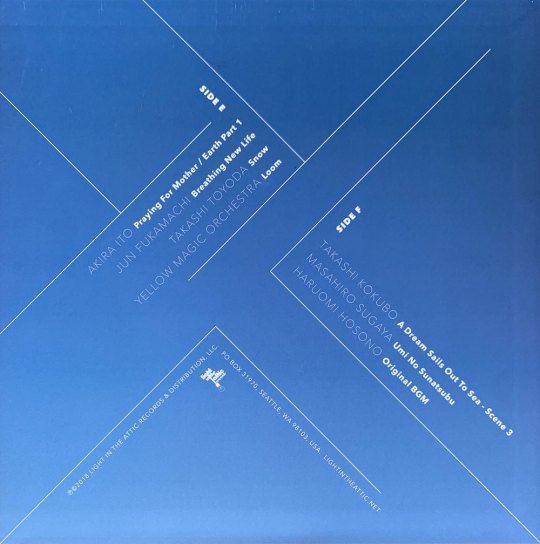
As just mentioned, The Far East Family band also launched the career of new age nature healer Akira Ito, who spent a long and productive career exploring the theme of yasuragi (translated in the liner notes as “peace of mind”). “Praying for Mother / Earth Part 1” sees a Floydian space prog ceremonial hovering above a mystical river. Rick Wright-style synth brass meditations and luminescent black hole drones recall “Shine On You Crazy Diamond” while bell-tone sequences fade in and out of the galactic ether. Frogs, birds, and insects grow increasingly ecstatic while helicopter oscillations swarm within a dark sonic mist and moving towards the end, celestial pads and angel voices join together for enchanting songs of sadness. Perhaps my favorite piece here comes form Takashi Toyoda, something of a child prodigy with an incredible range as evidenced by his participation in both the New Japan Philharmonic and the Taj Mahal Travellers. In “Snow,” trance inducing minimalist patterns swim through an astral sea of dreams as flutey synth bubbles dance around dreamworld melodies of overwhelming beauty. Majestic key changes sweep the spirit away to cloud castle utopias where pure white snow falls onto the slopes of an eternal mountain....the whole thing strongly evoking Emerald Web. And the ethereal vibes of harmony are pushed over the edge by Takashi’s lonely violin fantasias while golden gloss drops of feedback descend onto the mix like shooting stars. It’s one of the most magically transportive tracks I’ve ever heard…the kind of music that could heal the world...with pure starshine flows of light and love immersing the soul.

Jazz fusion and synthesizer master Jun Fukamachi appears with “Breathing New Life,” which was originally produced to accompany a fashion show. Ritualistic drums move side to side as ceremonial metals swell. Space winds blow over bubble-synth sequences…these softly squelching dream patterns flowing beneath feedback streaks and joyous drum clatters. Marimba solos dance on tropical clouds and bring vibes of island balearica and solar fusion, while swelling choirs radiate shadow energies. And as golden glitter hazes rain over the mix, ethereal voices and epic atmospheres wrap the heart in hues of sky blue and sunset orange. The inclusion of “Loom” by Yellow Magic Orchestra is another tribute to Hideki Matsutake, as this is the only YMO song co-written by Hideki. Based around the Shepard-Risset glissando illusion, the track keeps the mind and body in a constant state of anxious anticipation as interlaced sine waves continually ascend. There is a powerful yearning for melodic alignment...some sort of heavenly convergence of harmony and sonic power and indeed such a moment eventually arrives as massive pipe-organ dronewaves fly forth and recall the score of 2001: A Space Odyssey. All the while, ping-pong balls made of electronic energy bounce through infinite hallways and as the towering organ chords recede, they leave behind a contemplative weaving of blurred synthesis, with springtide orchestrations reso-filtered into glowing phaserfluids.
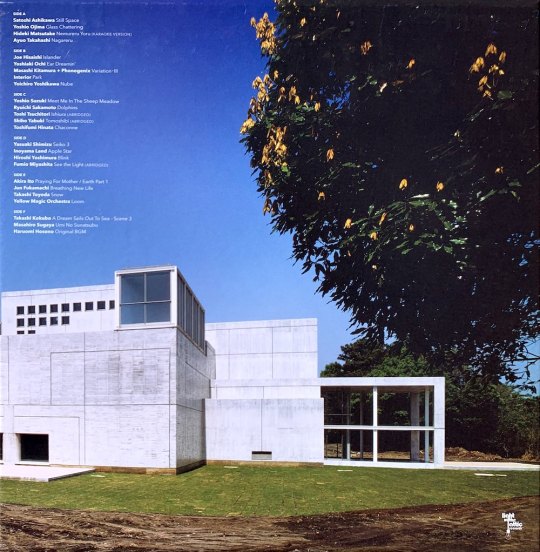
Takashi Kokubo’s Get at the Wave has featured prominently on this blog, and shows up here in the form of “A Dream Sails Out to Sea - Scene 3.” Seafloor choirs diffuse through flowing ocean layers alongside aqueous pinging tones and cascading pianos. The strange asymmetrical floating motions of exotic sea-creatures are evoked by drunken tremolos and warbling delays and eventually, the pianos work into a swooning post-classical love song as long flowing chime strand intertwine with wondrous harp runs. Masahiro Sugaya’s “Umi No Sunatsubu,” like most of his recorded work, comes from a theater production by the group Pappa Tarahumara (called Zoo of the Sea). Plinking upright pianos are close mic’d, with multiple layers drifting over each other. The sounds are old and detuned with no fx or overt production tricks…just strange ivory mesmerisms moving untethered through space and time. Kankyō Ongaku ends perfectly, with an expansive polysynth solo meditation from Haruomi Hosono called “Original BGM”. Here he is…stripped free of the concepts, the ironic humors, the sort of mercurial distance he typically maintains…baring his heart and soul through warm fantasias of synthetic brass. Sometimes he dances through single note dream spells, the decaying tails wavering through balmy modulations. Other times, hovering chord clusters transitions into descending runs that seem to fall over themselves, with occasional flights into soaring resonant feedback. It’s ethereal, exploratory, and deeply entrancing…a relaxing and impressionistic rendering of the cycles of nature.
(images from my personal copy)
#kankyō ongaku#ambient music#environmental music#new age#1980 - 1990#light in the attic#spencer doran#compilation#japan archival series#haruomi hosono#yasuaki shimizu#hiroshi yoshimura#satoshi ashikawa#brian eno#erik satie#bubble economy#japan#iwasaki art museum#fumihiko maki#yosuke kitazawa#terry riley#kosmische#sound design#corporate capitalism#blue skies#jun fukamachi#takashi kokubo#album reviews#vinyl reviews#music reviews
1 note
·
View note
Text


Eerie driftwood figures roaming the forest.
By Japanese artist, Nagato Iwasaki.
#artist#artwork#art#artists on tumblr#nature#japan#forest#sculptor#sculpture#monument#statue#tree#Nagato Iwasaki#black art#black and white#photooftheday#photografy#museum#museumnasional
2K notes
·
View notes
Photo

Shusaku Arakawa, Untitled, 1967, in Constructing The Perceiver – Arakawa: Experimental works, Foreword by Tadao Ogura, Edited by Kazuo Nakabayashi, Koji Takahashi, Kunio Motoe, and Yoshikazu Iwasaki, The National Museum Of Modern Art, Tokyo, 1991, p. 129
#graphic design#art#visual writing#catalogue#catalog#shusaku arakawa#tadao ogura#kazuo nakabayashi#koji takahashi#kunio motoe#yoshikazu iwasaki#the national museum of modern art tokyo#1960s#1990s
59 notes
·
View notes
Text

Tools at the exhibition
food creation「sensuous food, emotional taste, フードクリエイション 食欲のデザイン展 感覚であじわう 感情のテイスト」
art direction & design:
Naoko Fukuoka 福岡南央子_woolen
artist: food creation
photo: Hiroshi Iwasaki 岩崎寛
CL: 21st Century Museum of Contemporary Art, Kanazawa 金沢21世紀美術館
2008
#graphic#graphic design#woolen#naokofukuoka#design#foodcreation#福岡南央子#naoko fukuoka#諏訪綾子#ayakosuwa#food art#art exhibition#design_by_woolen
4 notes
·
View notes
Text




We celebrate Bonsai Empire's 21st birthday, with today: Crespi Bonsai
"Juniperus chinensis var. sargentii
height 100 cm. Origin: Japan
This specimen of Juniperus chinensis var. sargentii, created by the master Terukichi Kato, is characterized by a splendid processing of dry wood. Belonging to the collection of Daizo Iwasaki, it is a tree that is over 400 years old which since 2009 has become part of the masterpieces of the Crespi Bonsai Museum - Parabiago (Milan).
It is cataloged among the "National Treasures" of Japan, it is a specimen of great value, coming from one of the most famous bonsai nurseries, the Mansei-en, owned by the Kato family today in its 5th generation. The natural sargentii variety of Juniper (Miyama byakushin) is one of the most used plants in bonsai art. As its wood is very hard and resistant, it lends itself to the processing of dry wood: this character accentuates the charm of the specimen and makes it more intensely evocative of the hostile and severe environment that it normally represents.
Acer palmatum ‘Arakawa’
Height: 100 cm Origin: Japan
This magnificent Acer palmatum 'Arakawa', a rare example in the kabudachi style, has been in the collection of the Crespi Bonsai Museum in Parabiago (Milan) for about 30 years.
The dark and deeply fissured bark typical of this species creates an extraordinary contrast with the vegetation characterized by a dense fine branching, well drawn.
In autumn, the green leaves turn from yellow to deep red and golden, and then in winter give way to the bare silhouette where you can read the long and accurate work applied by sensei Nobuyuki Kajiwara, season after season, to achieve the desired results. For more: https://www.instagram.com/crespibonsai"
This post was shared to celebrate Bonsai Empire's 21st birthday. We share photos from well known Bonsai experts, museums and magazines in the next few weeks, so stay tuned!
18 notes
·
View notes
Text
Kotono's Thoughts on Taitō Division

Azusa Furukawa
"Even back when I worked with Chuohku, I heard about Furukawa and her family. Honestly, I don't know why Otome insisted on having her family take down their sign for their family dojo. It wasn't like they were hurting anyone but teaching them how to wield a sword. But then again, I don't know why I'm shocked. This seems like a standard thing for Otome and Chuohku to do..."
Fleuret Oshiro
"I'm actually a good friend of Fleuret's. I visited the Tokyo Museum once when I was in Taitō on business. She was working the floor that day, and despite not understanding much of what she was saying, she knew a lot about the art pieces, and did a hell of a job expounding on it. I'm not exactly an art person, but even I can appreciate it once in a while."
Eldrid Iwasaki
"I'm not as big of an MMA fan as Takumi is. Really, the only reason I watch it is because of this woman right here! Eldrid "The Valkyrie" Iwasaki. Believe it or not, she's partially the reason why I've started doing some yoga classes. Of course, I'll never be as fierce as her, but I've got to start somewhere, right?"
Blade Maiden
"Yeah, this division is, without a doubt, one of the best I've seen. I'd say there the ones likely to win the whole thing, but considering there are plenty of other divisions out there, I don't want to put all my eggs in one basket. Still, they've got a pretty good shot. I look to seeing who they face next! If it's us, I'm definitely looking forward to it!"
#hypnosis mic oc#hypmic#hypmic oc#hypnosis mic#hypnosis microphone#kiya kara#sendai division#kotono ohara#taito division#blade maiden#azusa furukawa#fleuret oshiro#eldrid iwasaki
8 notes
·
View notes
Photo

Chihiro Iwasaki - "ゆびきりをする子ども" 1966
Chihiro art museum: chihiro.jp
source: bijutsutecho.com
10 notes
·
View notes
